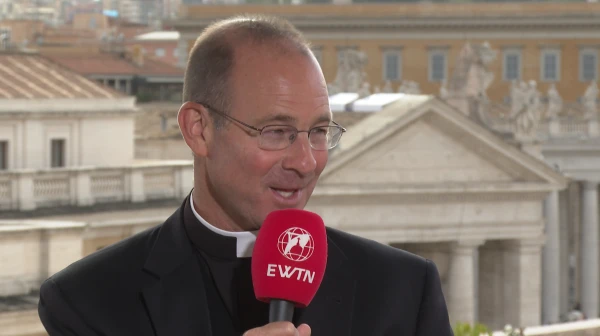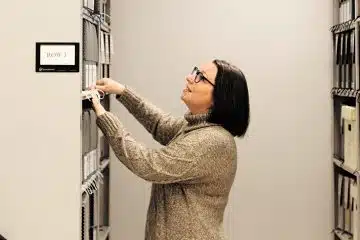‘The Atlantic’ publishes article on the rosary as symbol of far-right, violent extremism
Washington D.C., Aug 15, 2022 / 16:06 pm
An article published Sunday in The Atlantic magazine suggests the rosary has become a symbol of violent, right-wing extremism in the United States.
The article set off a frenzy of reactions among Catholics, ranging from amusement to grave concern over what some see as anti-Catholic sentiment.
The magazine later changed the article’s headline from “How the Rosary Became an Extremist Symbol” to “How Extremist Gun Culture is Trying to Co-Opt the Rosary.” Among other edits to the text, an image of bullet holes forming the shape of rosary was replaced with a picture of a rosary.

These editorial changes, nonetheless, left the article’s thesis that there is a connection between the rosary and extremism intact. The author’s contention was based, in part, on his observations about the use of the rosary on social media and rosaries sold online.
“The rosary has acquired a militaristic meaning for radical-traditional (or “rad trad”) Catholics,” writes Daniel Panneton of the sacramental used in prayer by Catholics for centuries.
“Militia culture, a fetishism of Western civilization, and masculinist anxieties have become mainstays of the far right in the U.S.—and rad-trad Catholics have now taken up residence in this company,” writes Panneton, whose article includes three links to Roman Catholic Gear, an online shop that sells rosaries.
He describes photos of rosary beads “made of cartridge casings, and complete with gun-metal-finish crucifixes,” along with warrior-themed memes and content catering to survivalists.
The Catholic reaction
Asked to comment on the article, Robert P. George, professor of political theory at Princeton University and former chairman of the United States Commission on International Religious Freedom (USCIRF), told CNA:
“It looks to me like the guy who is politicizing the rosary and treating it as a weapon in the culture war is … Daniel Panneton. I know nothing about the guy other than what he says in the article. I hadn’t heard of him before. Although it’s hard to miss the classic anti-Catholic tropes in the piece, perhaps he isn’t actually a bigot. Maybe he just overwrought and needs to take an aspirin or two and lie down for a while.”
Chad Pecknold, theology professor at Catholic University of America, told CNA the publication of the article points to a “theo-political” conflict in the culture.
“The politically elite core in left-liberal media hate Western civilization and they mean to topple every natural and supernatural sign of it. That’s why it’s not sufficient to simply run a piece on right-wing gun cultures, but they must tie it to something which is theologically central to the civilization they feel most threatens their progressive ziggurat. It’s a sign of the theo-political conflict which now grips us; even still, they severely underestimate the power of Our Lady to reign victorious over evil,” Pecknold said.
Fr. Pious Pietrzyk, OP, a Dominican priest of the Province of St. Joseph, told CNA, “The article is a long-running stream of inaccuracies, logical fallacies, and distortions.”
The author, he said, fails to understand that “the notion of ‘spiritual combat’ has been with the Church from time immemorial. Recall that a traditional view of Confirmation is that it made one a ‘soldier for Christ.'”
“The problem is that The Atlantic does not seem to understand what metaphor means. In no wise, does the notion of rosary as ‘combat’ imply physical violence,” Pietrzyk added.
On Twitter, Fr. Aquinas Guilbeau, OP, responded to the article with a photo of white-robed two friars wearing their traditional rosary beads around their waists. “ WARNING: The image below contains rosaries,” read the caption.
Novelist and essayist Walter Kirn commented that The Atlantic article itself serves as an example of “extremism.”
Eduard Habsburg, Hungary’s Ambassador to the Holy See, responded by conceding the rosary is indeed a weapon — used for centuries against evil:
Catholic beliefs seen as extreme
Panneton makes it clear in his article that it’s not just about the rosary.
In the course of his argument, he refers to Catholic beliefs as evidence of “extremism.”
He sees extreme views on masculinity in the Catholic faith. He writes: “The militarism also glorifies a warrior mentality and notions of manliness and male strength. This conflation of the masculine and the military is rooted in wider anxieties about Catholic manhood.”
“But among radical-traditional Catholic men, such concerns take an extremist turn, rooted in fantasies of violently defending one’s family and church from marauders,” he continues.
The Church’s defense of the right to life of the unborn is also evidence of ties to right-wing extremists, according to Panneton.
“The convergence within Christian nationalism is cemented in common causes such as hostility toward abortion-rights advocates,” he writes.
Pietrzyk, the Dominican priest interviewed by CNA said, “The author takes what are basic Catholic positions on the nature of the Church, Christian morality, and the like, and posit that they are somehow ‘extremist.’ This is classic misdirection.”
The rosary, a “weapon” of choice for centuries
The rosary, first promoted by the Dominican Order by the 16th century, is a form of prayer based on meditations on the life of Christ. The beads are a tool to help keep track of prayers that are recited before and the meditations.
Since 1571, popes have urged Catholics to pray the rosary. In doing so they have often employed military terms for these prayer “weapons.” In 1893, Pope Leo XIII saw the rosary as an antidote to the evils of inequality born of the Industrial Revolution, and during World War II Pius XI urged the faithful to pray it in hopes that “the enemies of the divine name (…) may be finally bent and led to penance and return to the straight path, trusting to the care and protection of Mary.”
More recently, Pope St. John Paul II, Pope Benedict XVI and Pope Francis have recommended the rosary as a powerful spiritual tool.













